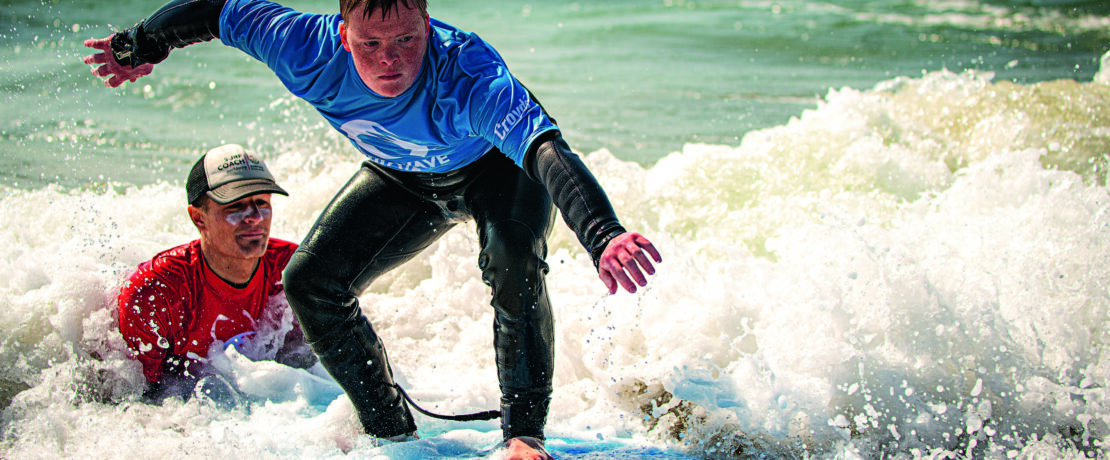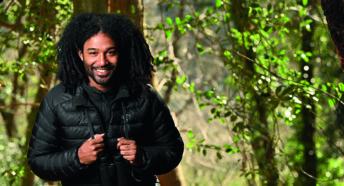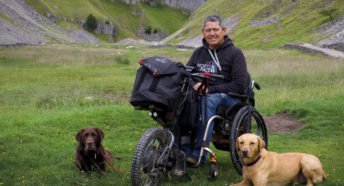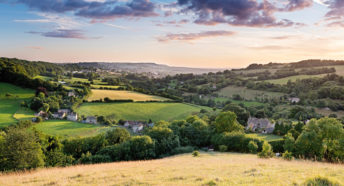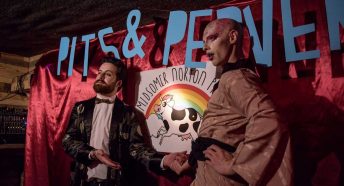Making waves: opening up green and blue spaces to people with disabilities
Not all of us can access the great outdoors equally easily – but, as Jane Yettram discovers, many groups are passionate about opening up the countryside and green spaces to those with disabilities.
Lying on a surfboard, you enter a different world. ‘It puts you in the moment,’ says Ian Bennett of The Wave Project surf therapy charity. ‘You’re looking at the horizon; at the water coming towards you. You’re at one with nature.’
Ian, a surfer for almost 30 years, knows how much this means to him. And through the adaptive surf hub for disabled learners at Croyde, north Devon, run by The Wave Project and Surf South West, he wants to bring that experience to everyone. The Wave Project was founded to improve the mental health and wellbeing of young people through surfing. ‘But in 2017, a mum called Nicki Palmer asked if I could take her son, George, who has multiple disabilities, surfing,’ says Ian.
‘She told me George has cerebral palsy and epilepsy, that he’s visually impaired, a wheelchair user, and has an intellectual disability. I suddenly realised the challenge – it was nerve-racking.’
Surfing for all
A small team took George surfing. He had a brilliant time – but Ian knew they could do better: ‘Even with George’s all-terrain wheelchair, it took three of us to get him onto the beach. And putting on his wetsuit was a real struggle. I was determined to do something about it.’
Since then, The Wave Project has developed adaptive surfing hubs in Croyde, Scarborough and Cornwall. ‘We now have boards with a raised chest for people who can’t lie flat, seated boards for people who can’t lie down, and beach wheelchairs with balloon wheels.’
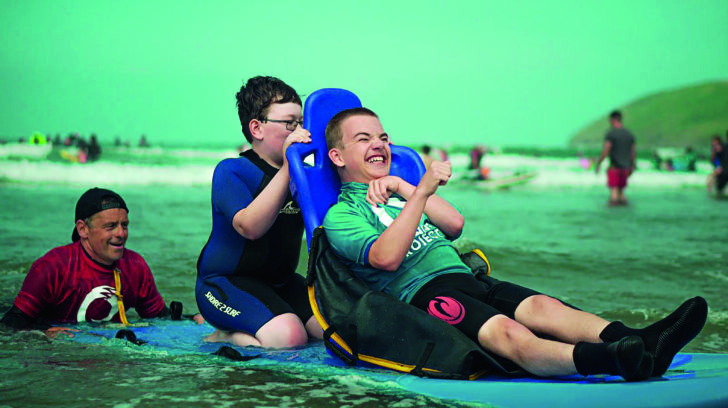
Super-stretchy wetsuits with arm and leg zips are easier to put on. ‘And the icing on the cake,’ says Ian, ‘has been opening a Changing Places unit, enabling people with disabilities to get into and out of wetsuits in a dignified, clean and warm environment. We have Access for All (a group founded by Nicki) as well as the beach owners (Ruda) and the local council to thank for that.’
Croyde’s adaptive surfing team now includes both qualified instructors and trained volunteers. ‘Our volunteers are vital because some participants need a lot of support. George, for example, needs a team of five, and Cliff – a stroke survivor who surfs as often as he can – needs a team of three.’ Individuals and groups with all disabilities, and of all ages, are welcome. ‘British Blind Sport has come several times,’ notes Ian. ‘The Silverlining Brain Injury Charity has come six years running. We even took them surfing in Lanzarote.’
Part of a community
Tom, 44, first came with British Blind Sport, emerging from his taster session buzzing. ‘Tom now surfs frequently,’ says Ian, ‘even competing in last year’s English adaptive surfing championships.’
Surfing presented Tom, who is severely visually impaired, with valuable challenges. ‘Overcoming these challenges has improved my self-confidence,’ he says. ‘I now feel part
of the surfing community.’
For Philip, too, who has chronic arthritis and is in his 60s, surfing has been life-changing. ‘Philip, who walks with a frame and is in constant pain, says surfing is the most free and alive he ever feels,’ explains Ian.
The fact that surfing is an adrenaline sport is fundamental for all surfers. ‘I’ve been working with Activity Alliance, the leading voice in sport for people with disabilities,’ says Ian. ‘Disabled people deserve the same chance as everybody else to get out of their comfort zone. Why shouldn’t they experience the same exhilarating fear factor that I have while surfing?’
Adventures on horseback
It’s an equally exciting experience for those getting on a horse for the first time at Saddleworth Riding for the Disabled – one of many Riding for the Disabled Association (RDA) groups around the country. First-timers may be nervous, but sheltering people with additional needs from the thrill of outdoor adventure does them a disservice.
As Alison Pickering, Saddleworth RDA co-founder, says, ‘One parent told us that everyone treated her daughter, who has cerebral palsy, like a china doll. Getting out on a pony made her just like other children.’
The setting of Saddleworth Stables, in the foothills of the Pennines, is spectacular – and some are experiencing it for the first time. ‘Our riders aren’t wealthy, and come from different cultural backgrounds. Most have never been near a horse and never go out in the countryside,’ says Alison.
But Alison and the other volunteers are skilled in engaging riders with the horses and the landscape – whatever the weather. ‘The sun could be shining down on a child’s face while they’re sitting on a pony. Or the wind and rain could be coming sideways, with the pony’s mane flapping. But the volunteers are always smiling, saying, “Oh, look at my face, it’s all red, look at the pony’s ears – that shows he doesn’t like the rain!”
‘We tie everything together – nature, weather, environment, climate,’ continues Alison. ‘We say, “Look, what are those sheep doing? Have you seen the pheasant?” We do mindfulness too, asking, “Can you hear the pony breathing? Can you feel him breathing?” When the children return, grinning from ear to ear, their parents are so proud.’
Therapy on horseback
There are some very real triumphs to celebrate. ‘Molly, aged nine, achieved her first RDA Endeavour Award recently, for nailing a rising trot. Those moments of success are really important.’
Molly’s mum, Caroline, was thrilled. ‘It’s an absolute joy to watch her. It’s the one thing Molly is always excited to do.’
Saddleworth RDA’s youngest rider is just four years old, but adults ride too. ‘One lady in her 50s is a double foot amputee,’ says Alison. ‘We’re also supporting children and adults with cerebral palsy, Down’s syndrome, hearing loss, ADHD, autism….’
Fourteen-year-old Abigail joined the group two years ago as part of her road to recovery after cancer treatment led to the removal of a major hip bone, reducing her weight-bearing ability. Alison says, ‘Abigail, a natural rider, has successfully competed at RDA regional level. Sitting on a pony, you’re balancing, strengthening your core, your upper body, your lower body. We don’t call it physio, but that’s what it is.’
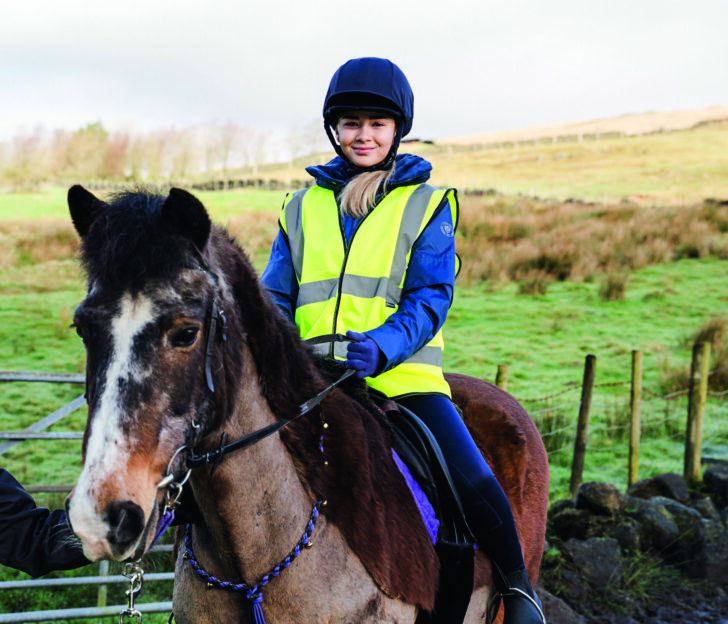
There are vast psychological benefits too. ‘For anybody experiencing a difference, a horse doesn’t see that you’re different. A horse accepts you as you are. And a horse teaches you things. From the minute they get on, children learn cooperation and empathy – with other people, with the pony.’
When six-year-old Jackson*, who has ADHD, first arrived, he couldn’t stop running and shouting. ‘The pony backed off. I said if he wanted to stroke the pony, he’d have to “be more horse”, because horses are calm, cool, chilled out. Suddenly Jackson was breathing quietly and stroking the horse. His parents were stunned. We have parents in tears at the change in their children.’
*Name changed
Sensory experiences
Bringing the therapeutic power of nature to others also motivates Sue Hooper, a leader of sensory walks for deaf and blind people.
‘During lockdown I was often in Lee Valley Regional Park – a 10,000-acre “green lung” spreading from London into Essex and Hertfordshire – and noticed groups of people with disabilities walking there,’ says Sue. ‘I wondered how much they got from it.’
Then Sue spotted an advert from Sense, a charity supporting people with complex disabilities, offering training to help people lead sensory walks.
As Sense’s Katie Sawyer explains, ‘We teach people how different senses can be used to engage with nature. This makes walking more meaningful and enjoyable for those with sensory impairments, who often have limited independence or time outdoors.’
Sue jumped at the chance to do the training, and Sense, delighted to find a passionate volunteer, helped set up the sensory walks in Lee Valley.
‘My two regular participants are Nicola, who is deaf and has little vision, and Matthew, who is deafblind,’ says Sue. ‘Their speech is limited too. Both are from a Sense residential home and come with their carers.
‘We concentrate on the flowers, the grasses, the trees. I have permission to take my secateurs and cut small sprigs of leaves and catkins for them to feel. On breezy days I hold their hands to grasses so they feel how things move with the wind.’
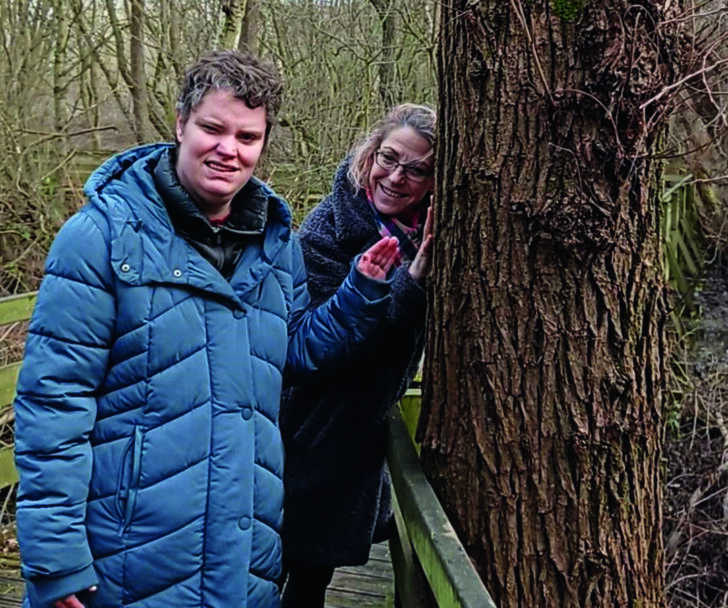
Sue focuses on the park changing over the seasons. ‘In spring, we discover new leaves, catkins, plants coming through the earth. In the autumn, it’s hips and haws, even walnuts.’
The carers take the items gathered back to the residential home. ‘They do an art activity, photographing residents’ creations,’ says Sue.
Carers themselves see benefits, too, adds Katie. ‘Sensory walks help them build a closer relationship with the person they’re supporting.’
The walks are so good for everyone that Katie wants greater numbers of people to benefit. ‘We’d love more care homes and individuals with disabilities to sign up, including from ethnically diverse communities – people from all backgrounds should be able to enjoy the countryside.’
‘Gained so much’
Last summer, Sue took out a group of children with autism. ‘We brought crayons and paper to do bark rubbings. The children really enjoyed it.’
She also takes two friends with severe illnesses. ‘They walked a lot when in full health. To do that again is so freeing.’
Sue herself has gained so much – including a greater appreciation of the countryside on her doorstep. ‘To know the park through the experience of people with different needs has given me a whole new way of looking at it.’
Her enthusiasm is shared by Ian at The Wave Project: ‘Getting people into the sea, seeing their faces, is amazing. Sometimes I can’t believe this is a job.’
As for Alison in Saddleworth, others’ joy gives her joy: ‘That’s why we don’t mind getting up at silly o’clock, at times so cold our feet feel like ice blocks! That doesn’t matter when we watch 12 happy children trundle off ruddy-cheeked after a wonderful ride in the countryside.’
